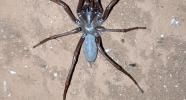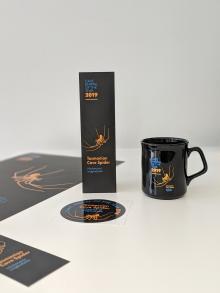
Nullarbor Blind Cave Spider
Welcome to Cave Animal of the Year
We’re excited to introduce our Australian Cave Animal of the Year for 2024. The Nullarbor Blind Cave Spiders, in the genus Troglodiplura, are large and long-legged spiders, only found in Australia and only within caves of the Nullarbor Plain.
Enigmatic predators of the dark
There is much that we do not know about Troglodiplura. Until a research trip in 2021, no scientists had seen a living adult Troglodiplura, and all five of the currently known species were only known from juvenile specimens, or from small broken fragments of adult males. Indeed, at the time of writing this, no living adult males have been recorded.
During the 2021 research trip, scientists observed a juvenile spider eating a cave beetle, so we know that beetles form part of their diet. It is also likely that they would eat other cave invertebrates that they come across, such as cave crickets, likely ambushing their prey in the dark. Troglodiplura are in a family of spiders called Wishbone Spiders (Anamidae), which mostly dig and occupy long burrows that are lined heavily with silk. So far, scientists have seen no evidence of burrow building, or such silk use in Troglodiplura – instead they appear to spend time in ‘the open', on the cave floor, or on the underside of rocks and to use small crevices and holes in the cave wall, within which to hide.
As their common name suggests, Nullarbor Blind Cave Spiders are highly adapted for a cave-living life. They have no eyes and elongate limbs, the tips of which are covered in dense mats of highly sensitive ‘hairs’. In the underground, where there is no light to see by, eyes are of no benefit; and it would take scarce nutrition and energy to maintain these unneeded organs. Meanwhile, long legs and their covering of sensory ‘hairs’ have evolved to become the ‘eyes’ – feeling the way in the blackened world of the underground. They are members of a primitive group of spiders called the mygalomorphs, which also includes tarantulas, funnel web spiders and trap door spiders, amongst others. Troglodiplura are considered one of the most cave-adapted mygalomorphs in the world, and the only cave-adapted mygalomorphs known from Australia.
We know of five species in the genus so far, but it is likely there are more out there, as many of the caves of the Nullarbor are yet to have had formal biological surveys for invertebrates.
A fragile world
Most species of Nullarbor Blind Cave Spider are known only from single caves, or from close and connected caves, making them dependent on the conservation of that cave, and the connecting pathways. While there is a lot yet for us to learn about threats to these spiders, it is likely that a number of threats have impacted them, including predation by foxes, human disturbance, and anything that impacts the fragile cave systems they live in.
Lady of the Spiders
The Troglodiplura genus was first described by Western Australian arachnologist Dr Barbara York Main OAM (1929-2019) who described 34 species of spider and seven genera: including Troglodiplura lowryi in 1969. Dr Main authored over 90 research papers and four books, including two books that documented the environmental costs of developing the wheatbelt area in Western Australia. The BBC and ABC produced a film about Dr Main’s work in 1981, entitled Lady of the Spiders. Dr Main was active in scientific research until her retirement at age 88.
Thailand cave rescue links
In 2018 the world was gripped by rescue of 12 young football players and their coach, from a team called the Wild Boars, after flood waters trapped them four kilometres inside Tham Luang Non, a cave system in northern Thailand. While all the football team and their coach were rescued after 18 days underground, one rescue diver, Mr Saman Kunan died during the rescue effort and another rescue diver Mr Beirut Pakbara died in 2019 from an infection contracted during the rescue. Two Australian cave divers, Dr Richard Harris and Dr Craig Challen played prominent roles in the rescue of the team and coach.
In 2020 four new species of Troglodiplura were described by Dr Mark Harvey and Dr Michael Rix, scientists from the Western Australian Museum. The scientists named these four species in honour of the two Thai cave divers and the two Australian cave divers. The four additional species of Troglodiplura being:
- Troglodiplura beirutpakbarai
- Troglodiplura samankunani
- Troglodiplura challeni
- Troglodiplura harrisi
More than a wide brown land
The Nullarbor is largely a ‘wide brown land’. The word itself means ‘no trees’. Far from a barren land this is a unique and sensitive landscape.
Home for the Nullarbor Blind Cave Spider is the Nullarbor karst. Karst is a geological term used to describe a landscape where dissolving of the bedrock creates features such as sinkholes, caves and underground streams. The most common type of karstic bedrock is limestone, but other types of karstic rock include dolomite and marble.
The Nullarbor is limestone karst and at over 200,000 square kilometres is Australia’s largest karst area and the largest arid karst area in the world.
The Nullarbor contains many caves, large open caverns and many blowholes (where strong updraughts can blow from underground). This landscape is unique in Australia. The caves provide sanctuaries from the extreme environments of the surface that include heat, cold, sun and wind.
For many tens of thousands of years, the caves of the Nullarbor provided shelter and resources to Aboriginal people and are intertwined to the ongoing culture of First Nations people who live in the area, or whose family connections are from the area.
Homes under threat
To many the ancient landscape of the Nullarbor is a waste land of little use. Developers have spied it, and there are plans afoot for thousands of wind turbines and extensive solar farms, to produce ‘green’ energy for an overseas market. The development would severely impact the sensitive cave systems that lie below the surface, caves that are home to species of the Nullarbor Blind Cave Spider that scientists have only recently discovered.
Who knows what other species live beneath the Nullarbor that humans are ignorant of.
Learn some more:









